精益生产在制造企业实施流程管窥 张英文
精益生产关键词中英文对照表
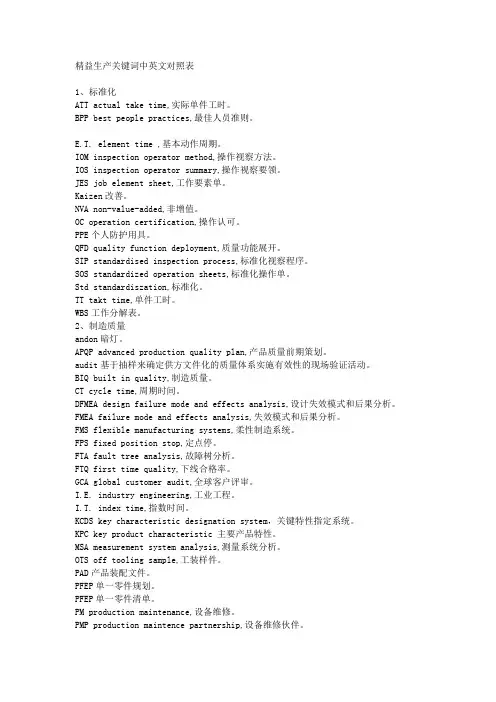
精益生产关键词中英文对照表1、标准化ATT actual take time,实际单件工时。
BPP best people practices,最佳人员准则。
E.T. element time ,基本动作周期。
IOM inspection operator method,操作视察方法。
IOS inspection operator summary,操作视察要领。
JES job element sheet,工作要素单。
Kaizen改善。
NVA non-value-added,非增值。
OC operation certification,操作认可。
PPE个人防护用具。
QFD quality function deployment,质量功能展开。
SIP standardised inspection process,标准化视察程序。
SOS standardized operation sheets,标准化操作单。
Std standardiszation,标准化。
TT takt time,单件工时。
WBS工作分解表。
2、制造质量andon暗灯。
APQP advanced production quality plan,产品质量前期策划。
audit基于抽样来确定供方文件化的质量体系实施有效性的现场验证活动。
BIQ built in quality,制造质量。
CT cycle time,周期时间。
DFMEA design failure mode and effects analysis,设计失效模式和后果分析。
FMEA failure mode and effects analysis,失效模式和后果分析。
FMS flexible manufacturing systems,柔性制造系统。
FPS fixed position stop,定点停。
FTA fault tree analysis,故障树分析。
FTQ first time quality,下线合格率。
精益生产中英文互译
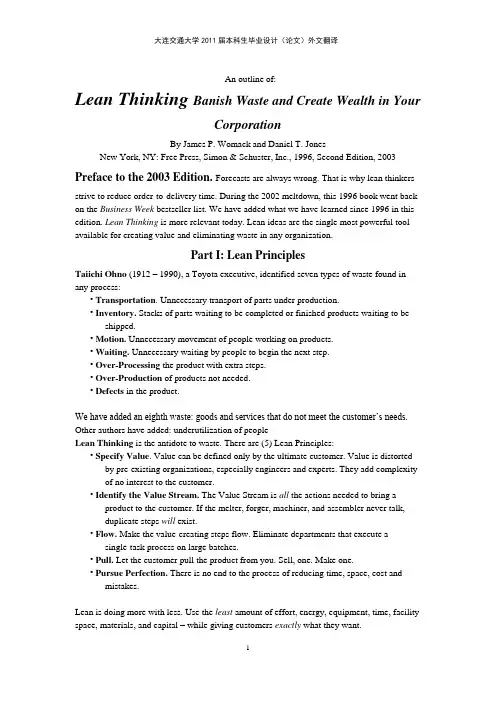
An outline of:Lean Thinking Banish Waste and Create Wealth in YourCorporationBy James P. Womack and Daniel T. JonesNew York, NY: Free Press, Simon & Schuster, Inc., 1996, Second Edition, 2003 Preface to the 2003 Edition. Forecasts are always wrong. That is why lean thinkersstrive to reduce order-to-delivery time. During the 2002 meltdown, this 1996 book went back on the Business Week bestseller list. We have added what we have learned since 1996 in this edition. Lean Thinking is more relevant today. Lean ideas are the single most powerful tool available for creating value and eliminating waste in any organization.Part I: Lean PrinciplesTaiichi Ohno (1912 – 1990), a Toyota executive, identified seven types of waste found in any process:• Transportation. Unnecessary transport of parts under production.• Inventory. Stacks of parts waiting to be completed or finished products waiting to be shipped.• Motion. Unnecessary movement of people working on products.• Waiting. Unnecessary waiting by people to begin the next step.• Over-Processing the product with extra steps.• Over-Production of products not needed.• Defects in the product.We have added an eighth waste: goods and services that do not meet the customer’s needs. Other authors have added: underutilization of peopleLean Thinking is the antidote to waste. There are (5) Lean Principles:• Specify Value. Value can be defined only by the ultimate customer. Value is distorted by pre-existing organizations, especially engineers and experts. They add complexity of no interest to the customer.• Identify the Value Stream. The Value Stream is all the actions needed to bring a product to the customer. If the melter, forger, machiner, and assembler never talk,duplicate steps will exist.• Flow. Make the value-creating steps flow. Eliminate departments that execute a single-task process on large batches.• Pull. Let the customer pull the product from you. Sell, one. Make one.• Pursue Perfection. There is no end to the process of reducing time, space, cost and mistakes.Lean is doing more with less. Use the least amount of effort, energy, equipment, time, facility space, materials, and capital – while giving customers exactly what they want.The Prize We Can Grasp Now. Converting a batch-and-queue system to continuous flow, with pull, will:Double labor productivity• Cut throughput time by 90%• Reduce inventory by 90%• Cut errors by 50%• Cut injuries1: ValueA House or a Hassle-Free Experience? Doyle Wilson Homebuilder found that customers “valued” a hassle-free design process and on-time delivery. All his processes were thenre-aligned to meet this goal.Define Value in Terms of the Whole Product. As the product flows, each firm defines value differently. Think of air travel. Each firm – agent, airline, taxi, currency exchange, customs, immigration – defines their own priorities, duplicates efforts, and works in disharmony with the whole process. The customer is not satisfied.2: The Value StreamThe View from the Aisle. A value stream “map” identifies every action to design, order, and make a specific product. Each step is then sorted into three categories: (1) those that add value, (2) those that add no value but are currently necessary, and (3) those that add no value and can be eliminated. After the third category has been eliminated, the second category should be addressed through flow, pull, and perfection techniques.The Value Stream for a Carton of Cola. The British grocery chain Tesco retails products with thousands of value streams. In the canned cola value stream, three hours of value-added activity take 319 days to perform.3: FlowThe World of Batch-and-Queue. Five-sixths of home-building is waiting for the next set of specialists or rework. Flow principles typically cut half the effort and the time required.The Techniques of Flow. The 1st step is to maintain focus on the product. The 2nd step is to ignore job boundaries and departments IOT remove impediments to continuous flow of the specific product. The 3rd step is to rethink work practices to eliminate backflow, scrap, and stoppages IOT make the product continuously.• Takt time synchronizes the rate of production to the rate of sales. (48) bikes per day sold divided by (8) hours of production = (6) bikes and hour, or (1) bike every tenminutes.• Flow requires all workers and machines to be capable at all times. This requires cross-training.• Flow requires workers to know the status of production at all times. This requires visual controls.• All activities can flow. Concentrate on the value stream for a specific product, eliminateorganizational barriers, and relocate and right-size tools.4: PullPull means that no one upstream should produce anything until the customer downstream asks for it. “Don’t make anything until it is needed, then make it very quickly.” “Sell one, buy one.” “Ship one, make one.”The Bad Old Days of Production. The Toyota bumper replacement system suffered long lead times. The ability to get parts quickly from the next upstream producer enabled re-orders in small amounts. This is the secret to reducing inventory. Cut lead times and inventories. Demand should instantly generate new supply.5: PerfectionThe Incremental Path. Freudenberg-NOK, a gasket manufacturer, improved a single process six times in three years. “Why didn’t they get is right the first time?” Because perfection is continuous.Continuous Radical and Incremental Improvement. If you are spending capital, you are doing it wrong. Once leaders understand the first four lean principles – value specification, value stream identification, flow, andpull – their perfection step starts with policy: a vision of the ideal process, and the step-wise goals and projects to get there. Transparency is everything. Everyone must know what you are attempting to achieve and what area is the first priority. The force behind this is the leader known as the change agent.Part II: From Thinking to Action: The Lean Leap6: The Simple CaseLantech manufacturers stretch wrap machines. “Process Villages” – Sawing department, Machining department, Welding department, Painting department, and Sub-assembly department – all generated long lead times. Batches of ten were manufactured to ship one. Inventory overwhelmed the factory. Order changes created havoc in the plant. “The more inventory yo u have, the less likely you will have the part you need.”• The Lean Revolution. Ron Hicks leaned Lantech. He created four cells, one for each product. He defined standard work: on time, on spec, every time. Takt time wasintroduced: number of products needed per day divided by number of hours (8/8 = 1hour). He right-sized machines to fit inside work cells. He implemented quickchangeover to make multiple different parts with little machine downtime.• Result. Lantech cut 30% excess space, doubled product output, cut defects from 8 per product to 0.8 per product, and cut lead time from sixteen weeks to fourteen hours.On-time shipping rose from 20 to 90%.7: A Harder CaseThe Change Agent. Art Byrne was hired as CEO of Wiremold in 1991. “CEOs are timid to change the shop floor.” Byrne led lean training using a manual he wrote himself. He led toursof the plant to observe waste that his managers were now able to see.• Improvements Must be Fast. Three days was Byrne’s standard.• Post a Scorecard for Each Product Team. Wiremold tracked: Productivity – sales per employee, Service – percent delivered on-time, Inventory – turns, and Quality –mistakes.• Teach People How to See. Create a lean training function. Teach all employees the five principles of lean: Value, Value Stream, Flow, Pull, and Perfection. Teach allemployees lean techniques: standard work, takt time, visual control, pull scheduling,and single-piece flow.• Results. Wiremold freed 50% factory floor space, eliminated a warehouse, and converted $11M of inventory into $24M in sales. Lead time fell from four weeks totwo days.8: The Acid TestPratt & Whitney (P&W). In 1991, CEO Karl Krapek and cost-cutter Mark Coran leanedP&W.• Jet Engines. Founded in 1860, P&W led the aircraft engine business by 1929. When they abandoned piston engines to gamble on jets in 1946, business soared. Production inefficiencies were overlooked.• Overcapacity. Faced with competition in the 1980s, P&W rationalized plant layout and addressed development costs. They needed lower production costs and flexibility toreact to customer needs. Why did P&W need so much space, tools, inventory andpeople to get so little done? Daily output of engines and spare parts could fit insideCEO’s office. Failure to manage ass ets. P&W cut people, cut managers, andoverhauled their entire production culture and processes.• The Monument of all Monuments. A “monument” is a machine or process too big to be moved and whose scale requires operating in batch mode. Monuments are evil, generating huge amounts of waste. P&W had an $80M grinding system, representing obsolete thinking. Although speeding up grinding from 75 minutes to 3 minutes and eliminating multiple manual grinding jobs, in actuality grinding jobs took longer (due to eight-hour changeovers and batch scheduling), and required more people (22 computer technicians). P&W retired the $80M monument, returned to 75-minute production.9: Lean Thinking versus German TechnikPorche. Chairman Wendelin Wiedeking introduced lean thinking to Porche. In 1994, the first-ever Porsche rolled off the line with nothing wrong with it.• Engineers. Porche is led by engineers, intrigued with unique solutions that are difficult to manufacture. Workers are craftsmen. Unfortunately, much craftsmanship is waste.Tinkering with the product – repairing and polishing raw materials, troubleshooting,re-assembling elements, repainting and re-fitting – were thought to be necessaryactivities to produce a high-quality product.• Crisis. 1986 was the boom year. 1992 was the crash. Porche products were tooexpensive. Costs and throughput time had to be slashed. New quality focus: “Stopfixing mistakes that should never have been made.” Reduction in inventory: “Whereis the factory? This is the warehouse!”• Just-in-Time (JIT) Game. Porche asked all their suppliers to play a simulation to learn lean concepts. Lean concepts were critical across all firms contributing to the Porche value stream.• The Remarkable Lean Transition at Porche. In five years, through 1997, Porch doubled its productivity, cut manufacturing space in half, cut lead time for a finished vehicle from six weeks to three days, cut supplier defects 90%, cut inventories 90%,and cut first-time-through errors by 55%.• The German Tradition. The Germans need to stop prioritizing the engineer’s definition of value, “voice of the engineer,” over the customer’s definition of value,“voice of the customer.” A German weakness is a fondness for monster machines that produce large batches: paint booths are an example.• Variety and Refinement Cost. Volkswagen makes four exterior mirrors, nineteen parts each, in seventeen colors. Nissan has four-part mirrors in four colors. Excess varietyoften exceeds the ability of the customer to notice, and his willingness to pay.10: Mighty Toyota; Tiny ShowaShowa has been transformed by its relationship with Toyota. Showa, a radiator manufacturer, had “Process villages” for casting, cleaning, stamping, welding, painting and assembly. Each was run in batch mode with long intervals between tool changes. Mountains of parts were transported and stored between steps.• The Initial Struggle. Taiichi Ohno, lean advisor, promised to reduce three months ofinventory to three days, double labor productivity, and halve plant space for zerocapital investment. This he did.• The Final Element: Rethinking Order-Taking and Scheduling. Showa then leanedorder-taking by scheduling backwards, working to takt time, to synchronize orderswith production slots, exactly four days before shipment time. Orders with incorrectinformation were never passed along.• Toyota Today. Lesson: high-tech automation only works if the plant can run at 100percent output and if the cost of indirect technical support and high-tech tools is lessthan the cost of direct labor saved.Part III: Lean Enterprise11: A Channel for the Stream; a Valley for the ChannelThe Lean Enterprise. No one watches the performance of the whole value stream. Identify all actions to bring a product to the customer, across all firms. There is no privacy. Eachfirm’s costs become transparent.12: Dreaming About PerfectionLong-Distance Travel. Each organization ignores the role of the other parties. The time, cost, and comfort of the total trip are key performance measures. What would travel times be without queues?Construction. 80% of home building is hurry-up and wait, then re-working the construction errors.The Prize We Can Grasp Right Now. Lean thinking can boost productivity while reducing errors, inventories, accidents, space requirements, production lead times, and costs in general. Lean thinking requires little capital.Part IV: Epilogue13: A Steady Advance of Lean ThinkingThis chapter an updated review of Wiremold, Toyota, Porsche, Lantech, and Pratt & Whitney.14: Institutionalizing the RevolutionAn Enhanced Action Plan is the 2003 update to the 1996 plan from Chapter 11.Getting Started [Months 1 – 6]• Find a Change Agent with ability and authority.• Get the Knowledge through an advisor. Start at the big picture before addressing small steps.• Seize a Crisis or create one. Focus on fixing an obvious problem. Small wins. Don’t spend money.• Map your current value streams. Managers need to see. Map also the flow of information going upstream to create a closed circuit. See Rother and Shook, Leaning to See, 1998.• Analyze each step of the Current State. Does this step create value? Is this step capable, available, flexible? Is capacity sufficient? Excessive? Does theinformation flow from the customer smoothly? Every process has a box score:total lead time, value creating time, changeover time, uptime, rework, inventory,every part made every x minutes. If this step went away, what would happen?• Envision the Future State. Draw it.• Begin as soon as possible with an important, visible activity. Convert managers with hand-on activity.• Demand Immediate Results. Everyone should see results which create psychological momentum. One week: less planning, more doing. Identify the waste and remove it.Communicate with your people by showing results at the scene of action.Creating an Organization to Channel Your Streams [Months 6 – 24]• Reorganize Your Firm by product and value streams. Put a Change Agent in charge of each product.• Create a Lean Promotion Team.• Deal with Excess People Early.• Devise a Growth Strategy.• Remove the Anchor Draggers.• When You’ve Fixed Something, Fix It Again.• New: Convince Your Suppliers and Customers to Take the Steps Just Described.Install Business Systems to Encourage Lean Thinking [Months 24 – 48]Create new ways to keep score.• Create new ways to reward people.• Make everything transparent so everyone can see progress.• Teach lean. Learn lean.• Right-size Your Tools to insert directly into the value stream. Large and fast is more efficient but less effective. This wrong assumption is the cornerstone ofbatch-and-queue thinking.• Pay a bonus. Tie bonus amount to the profitability of the firm.Completing the Transformation [Months 48 – 60] Convert to bottom-up initiatives. Lean ideas are democratic and not top-down. Layers of management can be stripped away.New: Convert From Top-Down Leadership to Bottom-Up Initiatives. Toyota gets brilliant results from average managers using brilliant procedures. Competitors get mediocre results from b rilliant managers using mediocre procedures. Don’t search for brilliant managers. Perfect your processes.Reviewer’s CommentsIn 1988 James Womack first described Toyota as a “lean” corporation. Womack and co-writer Daniel Jones described the Toyota Production System (TPS) in The Machine That Changed the World. In 1990, the two toured companies in Europe, North American, and Japan presenting ideas on how to convert mass production practices to lean practices. Lean Thinking, first published in 1996, is a survey of the lean movement. It clearly describes the waste found in mass production, explains the five principles of lean thinking, and then draws lessons from real companies who have successfully implemented lean ideas. Lean Thinking is not a technical how-to text on production, but an enlightened overview of top-level lean ideas and applications. This updated edition includes lessons that the authors have collected between 1996 and 2003, especially the concept of a lean enterprise – a collection of companies working lean together to produce a single product with the least wasted effort and capital. The book is well-written, researched, and organized, and the authors make a strong case that lean is universal and will benefit any organization in any endeavor. Lean thinking and practices are the single most powerful tool for eliminating waste in any organization.中文翻译概述精益思想去除浪费,并在贵公司创造财富由詹姆斯P.沃麦克和丹尼尔T.琼斯纽约编写,纽约:自由出版社,西蒙与舒斯特公司,1996年。
精益生产关键词中英文对照表
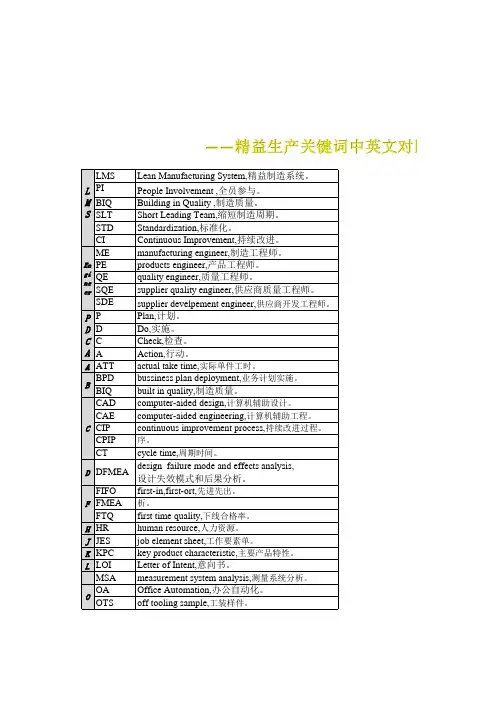
LMS Lean Manufacturing System,精益制造系统。
PIPeople Involvement ,全员参与。
BIQBuilding in Quality ,制造质量。
SLTShort Leading Team,缩短制造周期。
STDStandardization,标准化。
CIContinuous Improvement,持续改进。
MEmanufacturing engineer,制造工程师。
PE products engineer,产品工程师。
QE quality engineer,质量工程师。
SQEsupplier quality engineer,供应商质量工程师。
SDEsupplier develpement engineer,供应商开发工程师。
PPlan,计划。
DDo,实施。
CCheck,检查。
AAction,行动。
A ATTactual take time,实际单件工时。
BPD bussiness plan deployment,业务计划实施。
BIQbuilt in quality,制造质量。
CADcomputer-aided design,计算机辅助设计。
CAEcomputer-aided engineering,计算机辅助工程。
CIPcontinuous improvement process,持续改进过程。
CPIPthe current product improvement,现有产品改进程序。
CT cycle time,周期时间。
D DFMEA design failure mode and effects analysis,设计失效模式和后果分析。
FIFO first-in,first-ort,先进先出。
FMEA failure mode and effects analysis,失效模式和后果分析。
FTQ first time quality,下线合格率。
体现精益生产的文献

体现精益生产的文献英文回答:Lean manufacturing is a production philosophy thatseeks to eliminate waste and improve efficiency. It isbased on the principles of just-in-time delivery,continuous improvement, and respect for people.Just-in-time delivery means that materials aredelivered to the production line only when they are needed. This reduces inventory costs and frees up space for other activities. Continuous improvement means that employees are constantly looking for ways to improve their work processes. Respect for people means that employees are treated with dignity and respect, and their ideas are valued.Lean manufacturing has been shown to improve productivity, reduce costs, and improve quality. It hasbeen adopted by many companies around the world, including Toyota, Nike, and Dell.中文回答:精益生产是一种生产理念,旨在消除浪费并提高效率。
精益生产术语中英文版
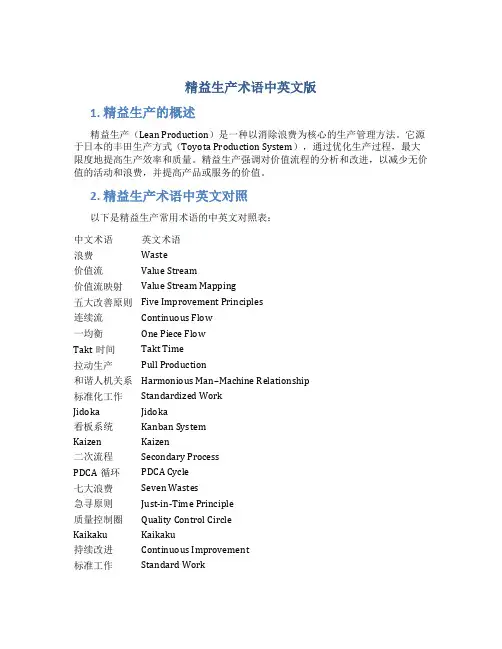
精益生产术语中英文版1. 精益生产的概述精益生产(Lean Production)是一种以消除浪费为核心的生产管理方法。
它源于日本的丰田生产方式(Toyota Production System),通过优化生产过程,最大限度地提高生产效率和质量。
精益生产强调对价值流程的分析和改进,以减少无价值的活动和浪费,并提高产品或服务的价值。
2. 精益生产术语中英文对照以下是精益生产常用术语的中英文对照表:中文术语英文术语浪费Waste价值流Value Stream价值流映射Value Stream Mapping五大改善原则Five Improvement Principles连续流Continuous Flow一均衡One Piece FlowTakt时间Takt Time拉动生产Pull Production和谐人机关系Harmonious Man–Machine Relationship标准化工作Standardized WorkJidoka Jidoka看板系统Kanban SystemKaizen Kaizen二次流程Secondary ProcessPDCA循环PDCA Cycle七大浪费Seven Wastes急寻原则Just-in-Time Principle质量控制圈Quality Control CircleKaikaku Kaikaku持续改进Continuous Improvement标准工作Standard Work3. 精益生产术语解释3.1 浪费(Waste)在精益生产中,浪费指的是任何不增加价值但增加成本和时间的活动。
这些活动是没有必要的,可以被消除或减少。
根据精益生产的理念,浪费被分为七类,即运输、库存、运动、等待、超生产、缺陷和过度加工。
3.2 价值流(Value Stream)价值流是指从原材料到最终产品或服务交付前的所有步骤和活动。
通过分析价值流,可以发现哪些步骤是无价值的或无必要的,并进行优化,以提高整体效率和质量。
精益生产术语中英文版
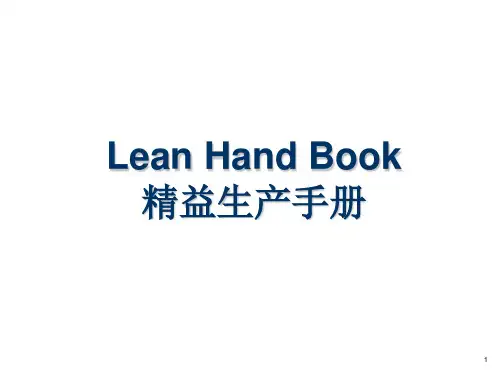
1
Kaizen Workshop ETE (End to End) Goal 改善目标
Productivity Improvement 端到端(从头到尾)产能提高
Double the Good 好的加倍 Halve the Bad 坏的减半 Double the Speed 改善速度加倍 ETE Zero Defect (Quality, TPM, OEE & etc.) 端到端(从 头到尾)零缺陷(质量,全面生 产维护,全局设备利用率等) Defect : 缺陷降低90% Inventory : 库存减半 Productivity : 生产效率翻倍 Lead Time : 生产周期减半 Scrap : 报废降低90% Space : 面积减半
Customer Demand 客户需求 22 Hours x 20 days x 3600 s 792,000 1,584,000 792,000 2 sec pcs
•Takt Time calculation shall display all the variable and units to make clarity to all. 计算节拍时间时要显示所有变量及单位,便于大家理解。
No Std Work means no Kaizen … Std Work is the Mother of all Kaizen 没有标准作业就没有改善„„标准作业是改善之母
5
How to start the Takt Time Calculation Based On Customer Demand 怎样根据客户需求计算节拍时间 • Step 1: Calculate Takt time Based on Customer Demand
精选精益生产-GenericPullSystem中英文对照
In a pull system, maintaining a “fixed WIP” keeps work orders in paThis provides the greatest flexibility to schedule/engineering changes. In addition, low WIP means a faster cycle time, which increases the probability releases are based on actual customer orders versus forecast.
Capability Analysis
AnalyzePropose Critical X’sPrioritize Critical X’sVerify Critical X’sEstimate the Impact of Each X on YQuantify the OpportunityPrioritize Root CausesConduct Root Cause
Analysis on Critical X’s
ImproveCritical X’s ConfirmedDevelop Potential SolutionsSelect SolutionOptimize SolutionPilot Solution
ControlImplement Process
Generic Pull System
我学到了什么?
理解在不同环境中使用这个工具的原因对于黑带潜在项目如何去使用这个工具
Generic Pull System
LEAN MANUFACTURING--精益生产
精益生产lean production定义:以丰田汽车公司为代表的新的资本主义生产方式。
其主要特征是对市场变化的快速反应能力、同一条流水线可以生产不同的产品、适时供应、多技能和具有团队精神的劳动力、对生产过程不断改进的动力与能力。
精益生产模式精益生产(Lean Manufacturing),简称“精益”,利用杜绝浪费和无间断的作业流程──而非分批和排队等候──的一种生产方式。
精益生产是衍生自丰田生产方式的一种管理哲学。
简介精益生产是通过系统结构、人员组织、运行方式和市场供求等方面的变革,使生产系统能很快适应用户需求不断变化,并能使生产过程中一切无用、多余的东西被精简,最终达到包括市场供销在内的生产的各方面最好结果的一种生产管理方式。
与传统的大生产方式不同,其特色是“多品种”,“小批量”。
精益生产又称精良生产,其中“精”表示精良、精确、精美;“益”表示利益、效益等等。
精益生产就是及时制造,消灭故障,消除一切浪费,向零缺陷、零库存进军。
它是美国麻省理工学院在一项名为“国际汽车计划”的研究项目中提出来的。
它们在做了大量的调查和对比后,认为日本丰田汽车公司的生产方式是最适用于现代制造企业的一种生产组织管理方式,称之为精益生产,以针对美国大量生产方式过于臃肿的弊病。
精益生产综合了大量生产与单件生产方式的优点,力求在大量生产中实现多品种和高质量产品的低成本生产。
精益生产给了我们一个理念,但是具体到每个企业的执行确是有很大区别的。
首先不同的企业在行业特点上不尽相同,就拿流程行业和离散行业来说,流程行业,比如化工,医药,金属等,一般偏好设备管理,如TPM(Total Productive Maintenance),因为在流程型行业需要运用到一系列的特定设备,这些设备的状况极大的影响着产品的质量;而离散行业,比如机械,电子等,LAYOUT,生产线的排布,以及工序都是影响生产效率和质量的重要因素,因此离散行业注重标准化,JIT(Just In Time),看板以及零库存。
Manufacturing Process生产过程管理程序(中英文)
1.0 Purpose目的To make sure that production processes of all products are in effective control so that a stable quality could be guaranteed, and customer requirements could be met.目的为确保公司所有产品的生产过程能够在有效的管理状态下进行,保证质量稳定,满足客户要求。
2.0 Scope范围Production of all Components made in our plant.本公司所有产品的生产过程。
3.0 Definitions定义Production delivery date: it refers to the delivery date marked in by Logistics. All the planned processes must be satisfactorily completed before the date, including the final products inspection and packaging.生产交货期:是指物流部确认的交货期,在此之前必须完成所有的生产过程,包括最终检验及包装。
4.0 Procedure and Flow chart 程序及流程图4.1 Responsibility and authority职责与权限4.1.1 AQP dept. is responsible for making the work instructions.项目部负责作业指导书制定。
4.1.2 Process engineer and quality engineer are responsible for making the inspection instructionof production working procedure, and also responsible for planning reference points ofdifferent working procedure.工艺工程师与质量工程师负责制订生产过程工序检验指导书和过程检验标准,并负责策划各工序控制点以及生产工艺流程。
精益生产(Lean Production)
27 h
全面生产系统的浪费
生产要素的5MQS: Man(人) Machine(机器) Material(物料) Method(作业方法) Management(管理) Quality(品质) Safety(安全)
28 h
5
M
Q
S
的 浪 费
分类
浪费
说明
人 的 浪 费
1. 行走的浪费 2. 监视的浪费 3. 寻找的浪费 4. 动作的浪费 5. 职责不清的浪费
零 停滞
交货期长、延迟交货多 缩短 顾客投诉多, 交货期 加班加点、赶工赶料
· 同步化、均衡化 · 生产布局改善 · 设备小型化、专用化
12 h
精益生产追求的目标
零目标 目的
现状
思考原则与方法
忙于赶货疲于奔命, · 安全第一
7个“零”目标 零 事故
安全 保证
忽视安全事故频发,
意识淡薄,人为事故 多
适品 ·适量 ·适时
平稳化 生产
适时化 生产
流线化 生产
安定化 生产
17 h
精益生产实施案例
中间在库0,一位停整线停
案例 松下电器大坂收音机工厂组装线
自动插件
插件1 插件2 插件3
焊接
自动
设备
组装1 组装2
检测
包装
1臂间距
极少数自动设备
多数手工作业 面向生产线
2H工位轮换 自主质量改进 (多技能)
· 经济批量 · 物流方式JIT · 生产计划标准化 · 作业管理 · 标准化作业
· 探求必要库存的原因 · 库存规模的合理使用 · 均衡化生产 · 设备流水化
零 浪费
降低 “地下工厂”浪费严 · 整体能力协调
- 1、下载文档前请自行甄别文档内容的完整性,平台不提供额外的编辑、内容补充、找答案等附加服务。
- 2、"仅部分预览"的文档,不可在线预览部分如存在完整性等问题,可反馈申请退款(可完整预览的文档不适用该条件!)。
- 3、如文档侵犯您的权益,请联系客服反馈,我们会尽快为您处理(人工客服工作时间:9:00-18:30)。
精益生产在制造企业实施流程管窥张英文发表时间:2019-04-17T16:32:22.870Z 来源:《基层建设》2019年第3期作者:张英文1,2[导读] 摘要:本文主要围绕精益生产在制造企业的实施流程展开研究,通过了解精益生产体系的构成,探究精益生产工作开展过程中的运营现状评估、方案制定以及实施的具体内容,推动精益生产各项工作更好地开展,保障企业生产效益。
1.东南大学经济管理学院江苏南京 210096;2.特雷克斯(常州)机械有限公司江苏常州 213022摘要:本文主要围绕精益生产在制造企业的实施流程展开研究,通过了解精益生产体系的构成,探究精益生产工作开展过程中的运营现状评估、方案制定以及实施的具体内容,推动精益生产各项工作更好地开展,保障企业生产效益。
关键词:精益生产;制造企业;实施流程1.精益生产体系一般来说,精益生产体系主要包括以下三个方面。
首先是均衡化,精益生产过程中应当设置节拍生产时间,在此基础上开展顺序生产和均衡负荷等工作。
其次是准时化,精益生产的重要目标之一即准时完成各项生产任务,使得产品供应可以按照预定时间开展。
此外,生产过程中还应当加强对自働化的重视,合理开展机器智能设计工作,使得在产品加工工作开展的过程中,机器也能及时观察到生产过程中出现的意外情况并发出警告,最终在精益化生产过程中实现零缺陷的目标,这也是精益生产过程中追求的重要发展目标之一。
2.经营生产在制造企业实施流程2.1运营现状评估工作精益化生产是企业在原有生产模式基础上的改进和发展,通过对生产现场的资源使用情况和各生产环境的资源支出等进行观察,找出存在资源浪费以及成本过度消耗等问题的地方,在此基础上开展后续各项工作,推动生产标准化等工作合理开展。
此外,相关人员还应当观察生产过程中操作人员和管理人员的工作状况,结合顾客需求等来开展后续各项工作,及时找出其工作过程中存在的不足,制定可以推动全员参与的工作条件。
此外,企业相关人员还应当及时开展事务性流程评估工作,运用访谈法等多种方法,合理开展事务性流程评估工作,通过与当前企业管理者等进行沟通,明确其各项工作开展过程中存在的问题和应当采取的解决方法,在此基础上对其相关工作进行必要的调整,推动企业生产等各项工作以合理方式开展,帮助高层管理者树立企业生产发展的信息,提高运营现状评估的质量。
2.2精益生产方案的制定工作精益生产开始之前,相关人员必须结合企业的生产发展状况,及时制定合理的组织机构方案,通过开设专业的部门,安排专业的管理人员和工作人员来开展各项工作,可以有效保障精益生产的质量。
在该方式下,精益生产工作开展过程中,可以由该部门来开展和生产计划制定工作,及时将收集到的各类信息和应当采取的解决措施等上报给高层,鼓励高层来开展方案调整等工作,引导相关管理者及时采取措施消除该类问题,推动生产各项工作以合理方式开展。
此外,为了保证管理人员的工作素质和工作能力,相关人员还应当及时制定管理人员培训和发展方案,通过对部门经理及相关领导人进行测试,明确其在精益生产工作开展过程中的问题和存在的不足,在此基础上开展培训方案制定工作,使其接受高质量的培训。
在此基础上,相关人员应当合理开展部门改善以及精益生产工具准备和应用等多项工作,推动该类管理者对企业的发展状况等形成更为深刻的理解,及时给予精益生产部门以各项支持,提高部门生产效率。
再次,企业管理者必须加强对一线生产人员管理和培训工作的重视。
在精益生产开展之前,通过与一线生产人员进行沟通,明确其对实施方案仍存在不理解的情况,在此基础上对相关方案进行调整,同时向生产人员发放一定数量的生产工具,组织一线生产员工定期开展生产培训等各项工作,部门内还要定期举办新生产知识交流会和技能培训实践等,运用多种方式来调动生产人员的生产积极性,提高生产人员的操作能力和操作素养,打造全面发展的一线生产员工,提高其对不同岗位的适应性。
最后,精益生产工作开展之前还应当加强对精益生产改善实验计划的重视。
在生产工作开展之前,应当结合生产过程中可能应用的生产工具和生产单元的开工顺序等,及时制定其具体的操作时间和结束时间表,安排专业的精益生产经理来组织该类员工参与各项改进工作,监督各项工作的开展情况,推动精益生产各项工作可以按时间完成。
精益生产实施方案制定过程中,领导者必须加强对各环节员工的重视,推动打造全员参与的企业发展环境,同时加强对各类生产工具的重视,结合精益生产过程中各类设备的使用顺序来开展后续工作,结合精益生产时间方案的相关要求来开展各项工作,调动员工的参与积极性,推动精益生产工作合理开展。
2.3精益生产在制造企业的实施流程精益生产在制造企业实际投入使用之后,相关人员必须加强对其各环节的实施标准以及实施要求等的重视,在此基础上开展生产改善等各项工作,推动后续各项工作以合理方式开展,主要包括以下几个方面。
首先,精益经理应该引导公司管理层企业远景,及现有困难痛点来发展公司的战略(Policy deployment),并把此战略转化为公司层面可衡量关键目标(OKR-objective and key results),,然后层层展开成为部门层面目标然后研究关键行动方案,并在日常管理中定期跟踪(DMS-daily management system).当有了公司层面的未来3年战略后,应该接着和管理层制定精益年度目标,及路线图并得到认可及承诺(后期需要支持)。
第二,合理开展前期准备工作。
在对原有精益生产方案进行改进之后,相关管理人员应当和管理层制定价值流程图,来发掘改善机会。
先用VSM来描绘现状并用精益工具来识别改善机会,然后设计未来价值流图(VSD),然后找出差距,制定计划来弥补差距。
此计划应该有清晰的责任人,清晰的日期,每周,每月review进展。
第三,合理开展精益生产组织健全工作。
每个部门的领导需要负责精益生产工具中某一个或几个元素的推广,培训及实施。
培训与发展不应该是精益部门的专有责任,应该有各个部门带头人来带动落实,并培训下属如何推广精益,这往往比某一个精益经理推广有效的多,被接受程度有效的多。
精益部门经理则负责开发教材,培训各个工具的负责人能足够理解内容并能独立开展工作。
同时精益经理应该开发出考核指标以衡量各部门经理开展得如何。
此目标应该由总经理带头每月度审核,季度总结,以确保从上至下坚决观察落实。
精益经理应作为顾问,培训师,引导者等角色。
第四,合理开展精益生产改进工作。
随着精益生产工作的不断推进,加上生产过程中出现的意外情况等造成的影响,精益生产方式可能会出现不适合生产等现象。
为此,精益生产管理部门要及时联合各环节的精益生产控制小组,结合问题出现的原因进行改进。
针对具体环节出现的问题,可以结合其具体原因,如生产人员操作问题、设备老化问题等进行处理,尽可能在一周内解决该类问题。
而针对相对较大的问题,特别是跨生产环节存在的问题,项目控制人员应当及时与相关责任人取得联系,共同寻找问题出现的原因并探究对应的解决方法,推动精益生产过程中出现的问题及时解决,以三个月内为宜,尽可能降低该类问题对企业生产等造成的影响。
同时,精益生产管理部门还可以结合精益生产改进的时间要求,成立一周问题改进方案,在每周一推行改进后的生产方案,在每周五汇报改进方案实施后取得的成果和仍存在的不足,并及时督促相关人员改进上述问题,可以有效提高精益生产过程中问题改进工作的质量。
同时领导者还要给予生产人员和管理人员等必要的鼓励,调动其开展各项工作的热情,推动后续各项工作以更为合理的方式开展,保障其整体工作质量。
精益部门要开发A3问题解决标准方法,从根本解决问题,使用好A3工具,确保大家不在救火层面,并成为公司通用工具,每个部门在汇报问题的时候使用,此工具是一种管理哲学,体现的是大野乃一的“三现主义”。
第五,推动基础管理工作合理开展。
在精益生产管理工作顺利开展的前提下,相关管理人员应当有计划地提高基础管理的质量,通过对公司的整体方案进行进一步的研究,明确精益生产工作开展过程中的检查方法,进一步细化精益生产管理部门的责任,推动其各项工作以合理方式开展。
在此基础上,公司应当加强对训练宣传工作的重视,结合精益生产过程中的培训要求和改进之后工作人员对生产设备等存在的不适应问题进行调整,帮助生产人员和管理人员进一步掌握精益生产各项工作开展过程中的注意事项和相关经验,推动其各项工作在新时期实现新的发展。
同时,精益化生产工作开展过程中还应当加强对员工日常管理工作的重视,结合员工日常行为中出现的问题,综合精益化生产的管理目标等对员工进行培训指导,帮助员工在精益化生产改进过程中实现新的发展,提高其工作能力和工作素质。
为了推动精益化生产过程中自働化的效率,领导者应当督促相关管理人员及时开展异常管理机制建设活动,结合精益化生产过程中经常出现的异常现象和异常原因等,及时采取对应的解决措施,同时以指标化和数据化为指导,建立物料信息异常管理系统,及时记录精益化生产过程中出现的异常问题和解决措施,为后续工作合理开展提供专业化意见指导,提高其整体工作质量。
为了保证员工可以观看到该类信息,管理者可以选择将其和企业的生产管理总系统连接起来,及时向员工推送该类内容,使得员工可以针对其具体情况开展实时分析等工作,推动相关工作尽快落实。
第六,精益化生产项目改进和新项目制定工作。
精益化生产方案改进之后,为保证其工作质量,精益生产部门管理者应当及时组织小组负责人员开展改进过程跟进工作,监督生产人员的工作状态和生产设备的运行情况。
在此基础上,及时组织生产回顾等工作,结合生产结果等开展后续各项工作,保障行动计划开展的有效性,提高其预期目标的实现质量。
精益部门管理人员还应当加强对精益生产方案不断改进的重视,把每一次方案改进都当作新方案实施,推动精益生产在新时期实现更好的发展。
3.小结企业推行精益生产改革是适应新时期社会发展和生产流程变革的要求,通过对生产组织结构和生产方式等进行改进,可以有效保障其工作质量,推动后续各项工作以更为合理的方式开展,减少生产过程中不必要的浪费,保障企业经营效益。
参考文献:[1]戴成宗,黄克久,田凤进,等.烟叶精益生产实施路径及实施成效分析--以移栽为例[J].重庆与世界(学术版),2016,(11):64-67.[2]李斯晨.精益生产方式及生产流程再造在中小企业中的应用研究--以“上海繁宝”企业为例[J].中小企业管理与科技,2015,(2):13-14.作者简介:张英文(1983-),男,南阳内乡人,东南大学MBA在读,研究方向为工商管理。
.。
